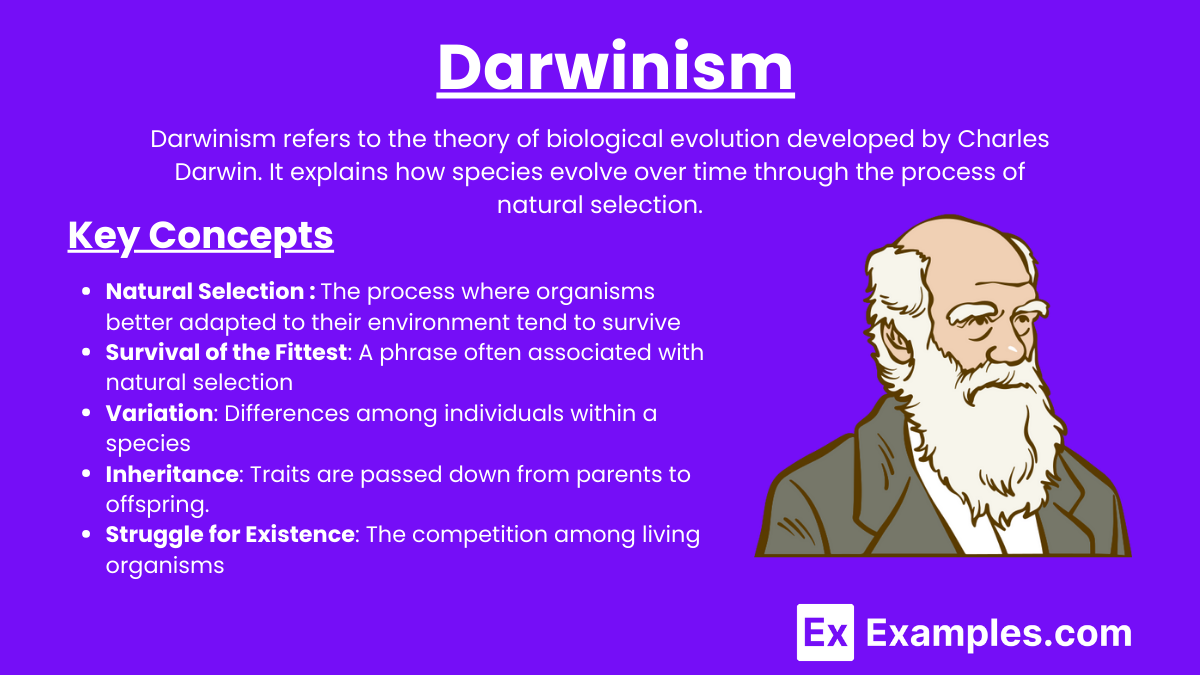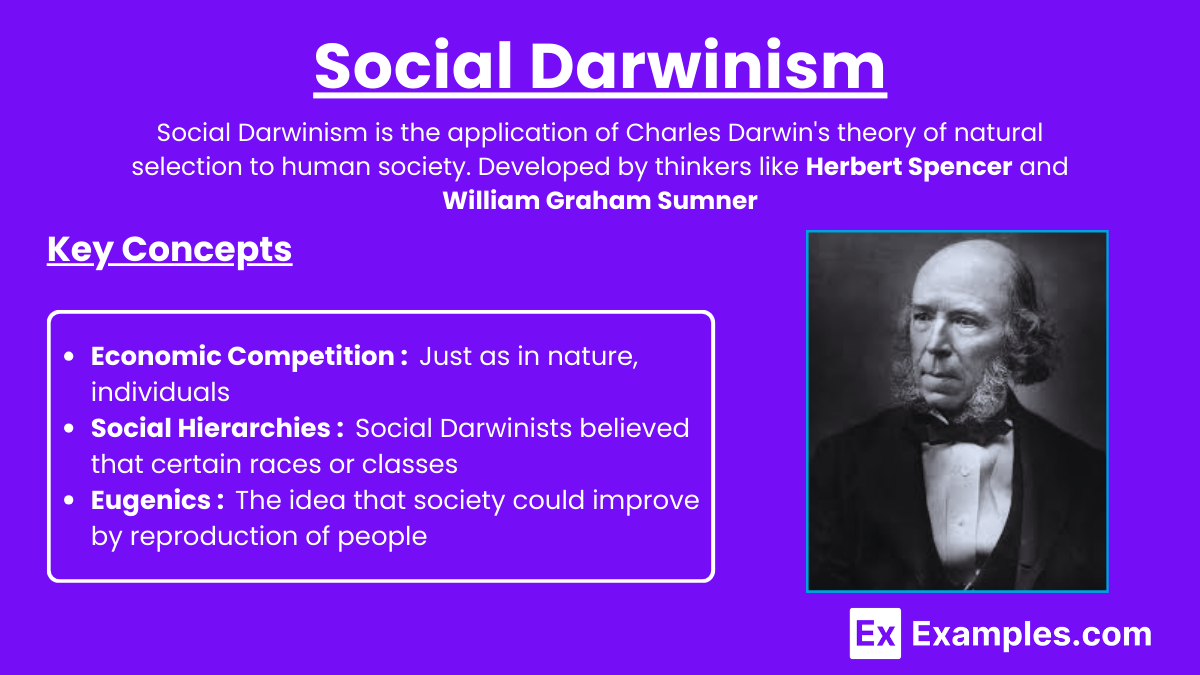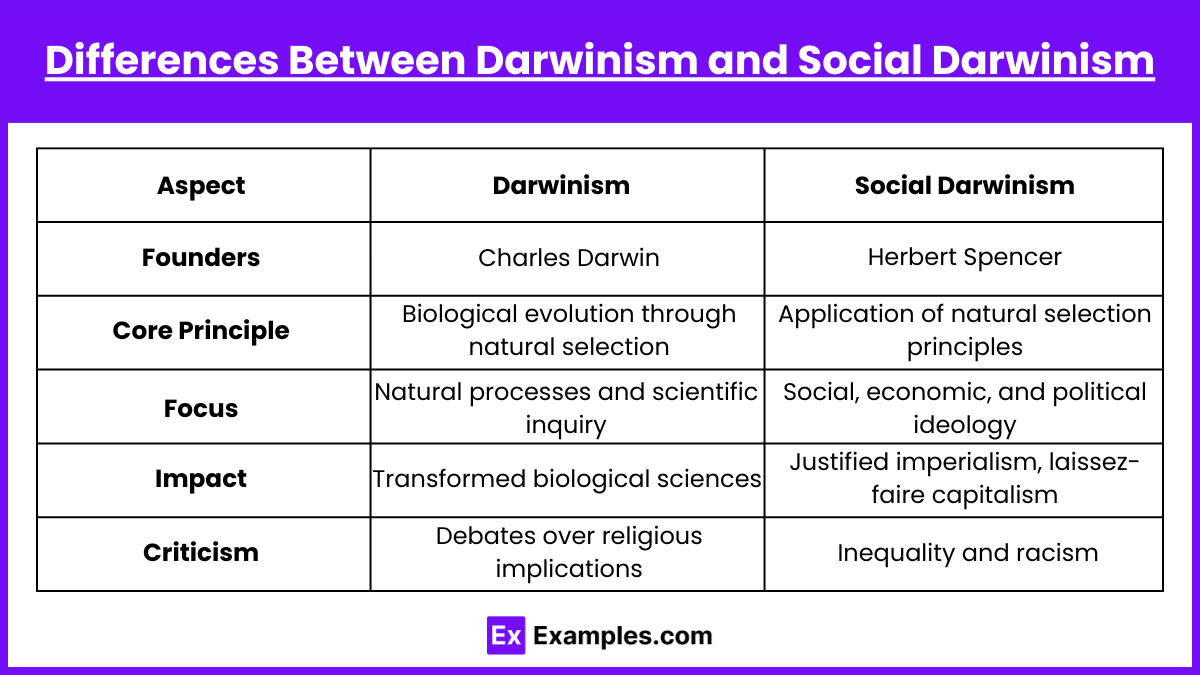Darwinism, formulated by Charles Darwin, revolutionized biological science with the theory of evolution by natural selection, explaining how species adapt and evolve over time. In the context of AP European History, Social Darwinism, developed by Herbert Spencer, applied Darwin’s principles to human society, advocating that “survival of the fittest” justified social hierarchies and laissez-faire capitalism. While Darwinism advanced scientific understanding, Social Darwinism often justified imperialism, racism, and economic inequality, leading to significant and controversial impacts on society and politics.
Learning Objectives
When studying Darwinism and Social Darwinism for the AP European History exam, you should aim to understand the core principles of Darwin’s theory of evolution, including natural selection and survival of the fittest. Grasp the historical context and impact of Darwin’s work on scientific thought. Additionally, comprehend how Social Darwinism applied these concepts to human society, influencing social, economic, and political ideologies. Analyze the ethical implications and criticisms of Social Darwinism, especially its role in justifying imperialism, racism, and social inequality.
Darwinism

Darwinism refers to the theory of biological evolution developed by Charles Darwin. It explains how species evolve over time through the process of natural selection.
Key Concepts
- Natural Selection: The process where organisms better adapted to their environment tend to survive and produce more offspring.
- Survival of the Fittest: A phrase often associated with natural selection, indicating that only the strongest or most adaptable organisms survive.
- Variation: Differences among individuals within a species, which can affect their ability to survive and reproduce.
- Inheritance: Traits are passed down from parents to offspring.
- Struggle for Existence: The competition among living organisms to survive in a habitat with limited resources.
Historical Context
- Publication of “On the Origin of Species” (1859): Darwin’s book presented the idea that species evolved over time through natural selection.
- Impact on Science: Darwin’s theories challenged the prevailing view of creationism and laid the groundwork for modern evolutionary biology.
- Controversy: Darwinism faced significant opposition from religious institutions and some scientific communities.
Key Figures
- Charles Darwin: Naturalist and geologist who proposed the theory of evolution by natural selection.
- Alfred Russel Wallace: Naturalist who independently conceived a theory of evolution similar to Darwin’s.
Social Darwinism

Social Darwinism is the application of Charles Darwin’s theory of natural selection to human society. Developed by thinkers like Herbert Spencer and William Graham Sumner, it suggests that the same principles of natural selection and survival of the fittest apply to social, economic, and political issues. Proponents argued that certain people become powerful in society because they are innately better. This ideology was used to justify various social inequalities, imperialism, and laissez-faire capitalism during the 19th and early 20th centuries. It suggested that wealth and social status were a result of inherent superiority, while poverty and lower status were due to lack of fitness. Critics argue that Social Darwinism ignores the complex social factors that contribute to economic and social status, promoting a deterministic view of human society that can perpetuate injustice and discrimination.
Key Concepts
- Economic Competition: Just as in nature, individuals and businesses compete for resources, leading to the success of the most capable.
- Social Hierarchies: Social Darwinists believed that certain races or classes were superior to others, justifying social inequality and imperialism.
- Eugenics: The idea that society could improve by promoting the reproduction of people with desirable traits and reducing the reproduction of those with undesirable traits.
Historical Context
- 19th and Early 20th Century: Social Darwinism gained popularity during this period, influencing various social policies and political ideologies.
- Industrial Revolution: The rapid industrialization and economic changes of the era provided a backdrop for the application of Darwinist ideas to society.
- Imperialism and Colonialism: Social Darwinist ideas were used to justify the expansion of European empires and the subjugation of non-European peoples.
Key Figures
- Herbert Spencer: Philosopher who coined the term “survival of the fittest” and applied Darwinian ideas to sociology and ethics.
- Francis Galton: Darwin’s cousin who founded the eugenics movement, advocating for the improvement of the human race through selective breeding.
- William Graham Sumner: American social scientist who argued that social progress resulted from the struggle for survival.
Differences Between Darwinism and Social Darwinism

| Aspect | Darwinism | Social Darwinism |
|---|---|---|
| Founders | Charles Darwin | Herbert Spencer |
| Core Principle | Biological evolution through natural selection | Application of natural selection principles to society |
| Focus | Natural processes and scientific inquiry | Social, economic, and political ideology |
| Impact | Transformed biological sciences, influenced religion | Justified imperialism, laissez-faire capitalism, eugenics |
| Criticism | Debates over religious implications | Seen as promoting inequality and racism |
Understanding Darwinism and Social Darwinism is crucial for grasping their profound impact on science, society, and politics. Darwin’s scientific contributions revolutionized biology, while Spencer’s application of these ideas to human society had both significant and controversial consequences. For the AP European History exam, focus on the key concepts, historical figures, and the broader societal implications to excel in your understanding of this topic.
Examples
Example 1
Natural Selection in Animals:
- Darwinism example: Charles Darwin observed finches on the Galapagos Islands, noting how their beak shapes evolved to adapt to different food sources. This adaptation through natural selection is a cornerstone of Darwin’s theory.
- Social Darwinism example: Herbert Spencer coined the phrase “survival of the fittest” to describe how human societies evolve. He argued that social institutions and hierarchies emerge because the strongest individuals or groups naturally dominate.
Example 2
Human Evolution:
- Darwinism example: Fossil records, such as the discovery of “Lucy,” a 3.2-million-year-old hominid skeleton, provide evidence for human evolution. These records support the idea that humans evolved over millions of years from common ancestors with other primates.
- Social Darwinism example: In the late 19th and early 20th centuries, some used Darwin’s ideas to justify racial and class hierarchies. They claimed that certain races or classes were more “evolved” and thus superior.
Example 3
Industrial Competition:
- Darwinism example: Darwin’s principles can be applied to the business world where companies compete for survival. Businesses that adapt to market changes thrive, while those that do not may fail.
- Social Darwinism example: During the Industrial Revolution, Social Darwinists argued that the success of wealthy industrialists like John D. Rockefeller was due to their superior abilities, using this to justify minimal regulation and harsh labor practices.
Example 4
Public Health Policies:
- Darwinism example: Understanding of natural selection and genetics informs modern public health strategies, such as the development of vaccines and treatments that target evolving pathogens.
- Social Darwinism example: In the early 20th century, some public health policies were influenced by eugenics, a form of Social Darwinism. Proponents argued for the improvement of the human population through selective breeding and sterilization of those deemed unfit.
Example 5
Educational Systems:
- Darwinism example: Educational curricula often include the teaching of evolutionary biology, demonstrating the impact of Darwin’s work on our understanding of life sciences.
- Social Darwinism example: Some education systems have been influenced by Social Darwinist thought, promoting competition and meritocracy as means to identify and cultivate the most “fit” students for leadership and success.
Multiple Choice Questions
Question 1:
Which of the following best describes the main principle of Darwinism?
a) The belief that all species were created simultaneously and have remained unchanged.
b) The idea that individuals with advantageous traits are more likely to survive and reproduce.
c) The concept that society should be structured to allow the strong to dominate the weak.
d) The notion that human behavior and societal structure are entirely determined by genetic factors.
Answer: b) The idea that individuals with advantageous traits are more likely to survive and reproduce.
Explanation: Darwinism, based on Charles Darwin’s theory of natural selection, posits that species evolve over time through a process where individuals with traits that provide a survival advantage are more likely to survive and reproduce. This leads to the gradual accumulation of beneficial traits in a population, driving evolutionary change. Options a, c, and d do not accurately capture the essence of Darwinism.
Question 2:
What is a key difference between Darwinism and Social Darwinism?
a) Darwinism applies to human society, while Social Darwinism applies to biological species.
b) Darwinism is a scientific theory, while Social Darwinism is a social theory.
c) Darwinism focuses on genetic inheritance, while Social Darwinism emphasizes cultural inheritance.
d) Darwinism advocates for the preservation of all species, while Social Darwinism promotes competition.
Answer: b) Darwinism is a scientific theory, while Social Darwinism is a social theory.
Explanation: Darwinism is a scientific theory that explains the process of evolution through natural selection, applicable to all living organisms. Social Darwinism, on the other hand, is a social theory that misapplies Darwinian principles to justify societal hierarchies and inequalities, suggesting that certain people or groups are naturally superior to others. This distinction is crucial as Social Darwinism extends biological concepts into social contexts, often with harmful implications.
Question 3:
Which statement about Social Darwinism is accurate?
a) It supports the idea that all individuals have equal opportunities to succeed.
b) It encourages social policies that aim to reduce inequality.
c) It was used to justify imperialism and racial discrimination.
d) It is a core principle of modern evolutionary biology.
Answer: c) It was used to justify imperialism and racial discrimination.
Explanation: Social Darwinism has historically been used to justify imperialism, colonialism, and racial discrimination by suggesting that the domination of “superior” groups over “inferior” ones is natural and desirable. This misuse of Darwinian ideas to promote social inequality and justify oppressive policies starkly contrasts with the scientific principles of Darwinism, which do not make value judgments about human society. Options a, b, and d misrepresent the nature and implications of Social Darwinism.


